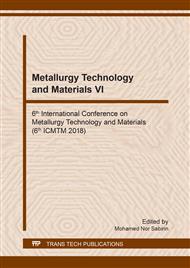p.109
p.113
p.119
p.124
p.130
p.135
p.143
p.148
p.153
Ultraviolet Radiation and Elevated Temperature Impact on Flexural and Swelling Properties of Glass Fiber Reinforced Plastic Pipes
Abstract:
The aim of this paper is to investigate whether ultraviolet radiation and elevated temperature influence the flexural strength, flexural modulus and swelling of glass fiber reinforced plastic pipes (GRP) over different aging periods. The degree of resistance to breaking on impact, and its measurement, is of practical importance in the selection and comparison of composite materials. Prepared samples from unused GRP pipe were subjected to ultraviolet radiation, humidity and elevated temperature prior to aging for 3, 6, 9, and 12 months in two different media, aquifer water and crude oil with high water cut. Flexural strength and modulus were obtained through a three-point bending test, results show that flexural strength noticeably decreases for samples aged in aquifer water when subjected to ultraviolet radiation. The exposed wet crude samples of composites to ultraviolet environment showed better flexural strength and modulus when compared to the unexposed samples. Maximum value of flexural strength (208 MPa) and flexural modulus (14.2 GPa) was observed for non UV aquifer water samples. In addition, swelling tests indicated that the pipe polymer matrix has a great resistance to solvent uptake which synergize with flexural modulus results for aquifer and wet crude samples. It can be found from this study that the combination of flowing chemicals in the pipe with the external factors such as elevated temperature and ultraviolet radiation have a notable impact over the polymer matrix and consequently on the composite physical properties .
Info:
Periodical:
Pages:
130-134
Citation:
Online since:
August 2018
Authors:
Keywords:
Price:
Сopyright:
© 2018 Trans Tech Publications Ltd. All Rights Reserved
Share:
Citation:


